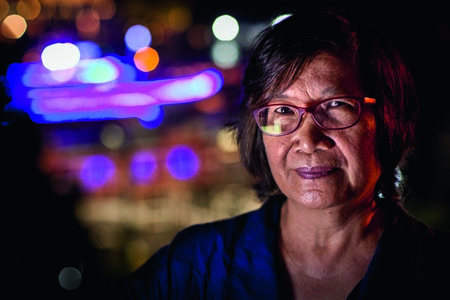Homecomings: The Educator
THE EDUCATOR: KANCHANA KANCHANASUT (MSc 1980, PhD 1991)
Dr Kanchana Kanchanasut has fond memories of her days as a PhD student in the University’s computer science department, when she and her student peers spent late nights on campus, often walking to Lygon Street for a coffee or pizza to talk through their research.

Kanchana Kanchanasut, director of Internet Education and Research Laboratory at the Asian Institute of Technology (AIT) in Thailand. Picture: Patrick Brown/Panos Pictures.
“Our department was really a home for me,” she says, “because we stayed and worked mostly during the night. “It was a real time of intellectual exposure for me.”
It was the 1970s and ’80s, when computer science researchers around the world were just discovering ways to connect their individual networks across borders. And it was that need to share ideas that led to the worldwide system we know today.
Kanchanasut is now professor and director of the Internet Education and Research Laboratory at the Asian Institute of Technology in Thailand. But it was her need to talk to her former University colleagues in Melbourne that led her to create a computer communication channel to Australia and countries around the world, opening Thailand to the internet.
“For Thailand, the first group of people that needed connectivity were academics,” she says. “Once you enjoyed the benefit, you wanted to share it with as many people as possible.”
Born into a family of 11 in Tak Province, near the Myanmar border, Kanchanasut could not have envisaged a future working with computer systems, but her academic strengths were clear.
“The blend of maths and machines was ideal for me.” Kanchanasut attended the University of Queensland on a scholarship to study mathematics. But it was the late 1960s and early ’70s, making for a difficult transition for a young woman and international student in a time of great turmoil for the region.
“It was during the Vietnam War,” she says. “A lot of anti-war protests were ongoing. It was quite an experience coming from a country with so many US military bases.”
Kanchanasut moved on to the University of Melbourne, where she worked as a programmer within the then Faculty of Medicine. She studied part-time and would eventually complete a Master’s degree and PhD in computer science.
When she returned to Thailand to join the faculty of the Asian Institute of Technology (AIT), Kanchanasut found that she could no longer connect to mailing lists and discussion groups she had access to through the University of Melbourne’s UNIX system, a pre-internet platform used by programmers and academics to communicate with each other.
“I was completely cut off from mailing lists and useful discussion groups. That was my motivation to get connected.”
In 1986, Kanchanasut and another colleague at AIT started working on setting up a UUCP connection, which links UNIX systems together, allowing them to transfer files and messages.
Working with Robert Elz, a renowned University systems engineer and internet pioneer, Kanchanasut set up a UUCP gateway to other systems in Melbourne, France and Tokyo. They could suddenly talk to computing academics around the world.
It was Thailand’s first connection to what would become the internet of today.
Kanchanasut, who also founded the .th internet domain as a result of her work, remains its administrative contact point. In 1998, she was one of 13 members appointed to the first membership advisory committee for ICANN, the non-profit organisation responsible for managing the internet.
Recognised around the world as an internet pioneer, Kanchanasut wants to continue to bring the internet to people who need it. She researches simple and economic wireless internet opportunities for post-disaster and remote community networks.
By Kate Stanton.
Read all of our Homecomings stories here.



